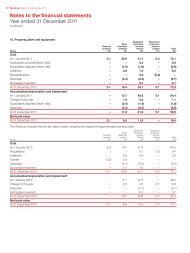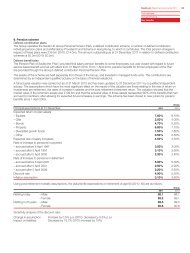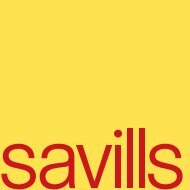Savills plc 2012 Annual Report - (PDF) - Investor relations
Savills plc 2012 Annual Report - (PDF) - Investor relations
Savills plc 2012 Annual Report - (PDF) - Investor relations
You also want an ePaper? Increase the reach of your titles
YUMPU automatically turns print PDFs into web optimized ePapers that Google loves.
Notes to the financial statementsYear ended 31 December <strong>2012</strong>continuedMethod of impairment testingAll recoverable amounts were determined based on value-in-use calculations. These calculations use discounted cash flow projectionsbased on financial budgets approved by management covering a five-year period. Cash flows beyond the five-year period areextrapolated using a terminal value. There was no impairment charge for goodwill and intangible assets arising from the the annualimpairment tests conducted (2011: £5.4m).AssumptionsMarket recoveryIn each case the models used assume that the property markets in which the Group operates (which drive its revenue growth) beginor continue to recover during 2013/2014.Discount rateThe discount rate applied to cash flows of each CGU is based on the Group’s Weighted Average Cost of Capital (WACC). WACC is theaverage cost of sources of financing (debt and equity), each of which is weighted by its respective use.Key inputs to the WACC calculation are the risk free rate, the equity market risk premium (the return that <strong>Savills</strong> shares provide over therisk free rate), beta (reflecting the risk of the Group relative to the market as a whole) and the Group’s borrowing rates.Group WACC was adjusted for risk relative to the country in which the assets were located. The risk adjusted pre-tax discount range ofrates used in each region for impairment testing are as follows:<strong>2012</strong>Pre-tax discount rate range2011Pre-tax discount rate rangeUnited Kingdom 10.9% 11.0%Continental Europe 10.9 – 11.9% 11.0 – 11.5%Asia Pacific 9.5 – 21.3% 6.3 – 21.3%America 12.9% 12.5%Long-term growth rateTo forecast beyond the five years covered by detailed forecasts, a terminal value was calculated, using an average long-term growth ratedetermined at 1.5%. This reflects management’s expectations based on historical growth and current market conditions and does notexceed the long-term growth rate in any country in which the Group operates.Sensitivity to changes in assumptionsThe level of impairment is a reflection of best estimates in arriving at value in use, future growth rates and the discount rate applied tocash flow projections. Nonetheless, there are no CGUs which management considers a reasonable possible change in a keyassumption would give rise to an impairment, apart from the Group’s US business. If revenue growth rate assumptions decreased by2.7% per annum between 2014 and 2017, this would begin to give rise to an impairment charge in the US.Future impairments on goodwill and intangible assets relating to any of the Group’s investments may be impacted by thefollowing factors:Market conditions – the timing and growth expectations for further recovery are key assumptions in the determination of the cash flowprojections. For the purposes of the impairment tests, management expects the market to improve slightly over 2013 for the next year,but anticipate a bigger improvement from 2014 onward.Cost base – the cost base assumptions reflects <strong>2012</strong>’s costs with limited growth in the fixed cost base going forward. Commissions andprofit shares are correlated to the Group’s revenue and profits and the percentage payout. These are assumed to be consistent withexisting rates.88 <strong>Savills</strong> <strong>plc</strong> <strong>Report</strong> and Accounts <strong>2012</strong>
















